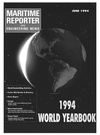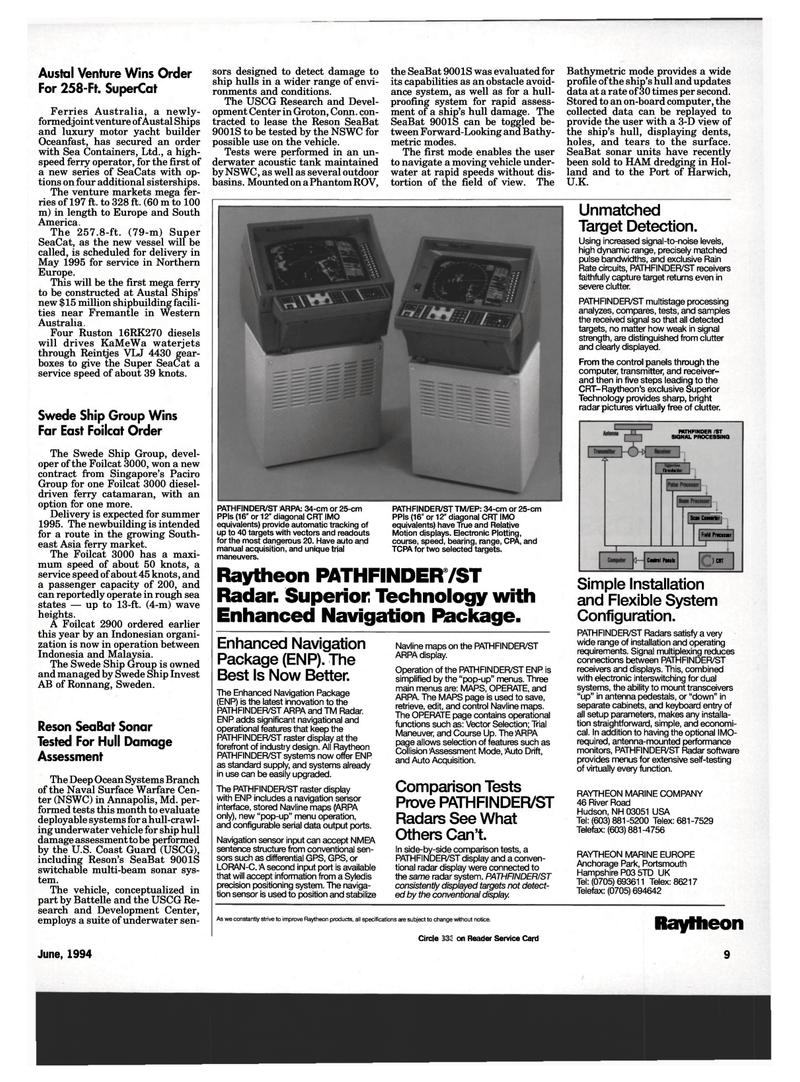
Page 7: of Maritime Reporter Magazine (June 1994)
Read this page in Pdf, Flash or Html5 edition of June 1994 Maritime Reporter Magazine
Austal Venture Wins Order
For 258-Ft. SuperCat
Ferries Australia, a newly- formed joint venture of Austal Ships and luxury motor yacht builder
Oceanfast, has secured an order with Sea Containers, Ltd., a high- speed ferry operator, for the first of a new series of SeaCats with op- tions on four additional sisterships.
The venture markets mega fer- ries of 197 ft. to 328 ft. (60 m to 100 m) in length to Europe and South
America
The 257.8-ft. (79-m) Super
SeaCat, as the new vessel will be called, is scheduled for delivery in
May 1995 for service in Northern
Europe.
This will be the first mega ferry to be constructed at Austal Ships' new $15 million shipbuilding facili- ties near Fremantle in Western
Australia
Four Ruston 16RK270 diesels will drives KaMeWa waterjets through Reintjes VLJ 4430 gear- boxes to give the Super SeaCat a service speed of about 39 knots.
Swede Ship Group Wins
Far East Foilcat Order
The Swede Ship Group, devel- oper of the Foilcat 3000, won a new contract from Singapore's Paciro
Group for one Foilcat 3000 diesel- driven ferry catamaran, with an option for one more.
Delivery is expected for summer 1995. The newbuilding is intended for a route in the growing South- east Asia ferry market.
The Foilcat 3000 has a maxi- mum speed of about 50 knots, a service speed of about 45 knots, and a passenger capacity of 200, and can reportedly operate in rough sea states — up to 13-ft. (4-m) wave heights.
A Foilcat 2900 ordered earlier this year by an Indonesian organi- zation is now in operation between
Indonesia and Malaysia.
The Swede Ship Group is owned and managed by Swede Ship Invest
AB of Ronnang, Sweden.
Reson Sea Bat Sonar
Tested For Hull Damage
Assessment
The Deep Ocean Systems Branch of the Naval Surface Warfare Cen- ter (NSWC) in Annapolis, Md. per- formed tests this month to evaluate deployable systems for a hull-crawl- ing underwater vehicle for ship hull damage assessment to be performed by the U.S. Coast Guard (USCG), including Reson's SeaBat 9001S switchable multi-beam sonar sys- tem.
The vehicle, conceptualized in part by Battelle and the USCG Re- search and Development Center, employs a suite of underwater sen-
June, 1994 sors designed to detect damage to ship hulls in a wider range of envi- ronments and conditions.
The USCG Research and Devel- opment Center in Groton, Conn, con- tracted to lease the Reson SeaBat 900 IS to be tested by the NSWC for possible use on the vehicle.
Tests were performed in an un- derwater acoustic tank maintained by NSWC, as well as several outdoor basins. Mounted on a Phantom ROY, the SeaBat 900 IS was evaluated for its capabilities as an obstacle avoid- ance system, as well as for a hull- proofing system for rapid assess- ment of a ship's hull damage. The
SeaBat 9001S can be toggled be- tween Forward-Looking and Bathy- metric modes.
The first mode enables the user to navigate a moving vehicle under- water at rapid speeds without dis- tortion of the field of view. The
Bathymetric mode provides a wide profile of the ship's hull and updates data at a rate of 30 times per second.
Stored to an on-board computer, the collected data can be replayed to provide the user with a 3-D view of the ship's hull, displaying dents, holes, and tears to the surface.
SeaBat sonar units have recently been sold to HAM dredging in Hol- land and to the Port of Harwich,
U.K.
Unmatched
Target Detection.
Using increased signal-to-noise levels, high dynamic range, precisely matched pulse bandwidths, and exclusive Rain
Rate circuits, PATHFINDER/ST receivers faithfully capture target returns even in severe clutter.
PATHFINDER/ST multistage processing analyzes, compares, tests, and samples the received signal so that all detected targets, no matter how weak in signal strength, are distinguished from clutter and clearly displayed.
From the control panels through the computer, transmitter, and receiver- and then in five steps leading to the
CRT-Raytheon's exclusive Superior
Technology provides sharp, bright radar pictures virtually free of clutter.
PATHFINDER/ST ARPA: 34-cm or 25-cm
PPIs (16" or 12" diagonal CRT IMO equivalents) provide automatic tracking of up to 40 targets with vectors and readouts for the most dangerous 20. Have auto and manual acquisition, and unique trial maneuvers.
PATHFINDER/ST TM/EP: 34-cm or 25-cm
PPIs (16" or 12" diagonal CRT IMO equivalents) have True and Relative
Motion displays. Electronic Plotting, course, speed, bearing, range, CPA, and
TCPA for two selected targets.
Raytheon PATHFINDER7ST
Radar. Superior Technology with
Enhanced Navigation Package.
Enhanced Navigation
Package (ENP). The
Best Is Now Better.
The Enhanced Navigation Package (ENP) is the latest innovation to the
PATHFINDER/ST ARPA and TM Radar.
ENP adds significant navigational and operational features that keep the
PATHFINDER/ST raster display at the forefront of industry design. All Raytheon
PATHFINDER/ST systems now offer ENP as standard supply, and systems already in use can be easily upgraded.
The PATHFINDER/ST raster display with ENP includes a navigation sensor interface, stored Navline maps (ARPA only), new "pop-up" menu operation, and configurable serial data output ports.
Navigation sensor input can accept NMEA sentence structure from conventional sen- sors such as differential GPS, GPS, or
LORAN-C. A second input port is available that will accept information from a Syledis precision positioning system. The naviga- tion sensor is used to position and stabilize
Navline maps on the PATHFINDER/ST
ARPA display.
Operation of the PATHFINDER/ST ENP is simplified by the "pop-up" menus. Three main menus are: MAPS, OPERATE, and
ARPA. The MAPS page is used to save, retrieve, edit, and control Navline maps.
The OPERATE page contains operational functions such as: Vector Selection; Trial
Maneuver, and Course Up. The ARPA page allows selection of features such as
Collision Assessment Mode, Auto Drift, and Auto Acquisition.
Comparison Tests
Prove PATHFINDER/ST
Radars See What
Others Can't.
In side-by-side comparison tests, a
PATHFINDER/ST display and a conven- tional radar display were connected to the same radar system. PATHFINDER/ST consistently displayed targets not detect- ed by the conventional display.
PATHFINDER 1ST
SIGNAL PROCESSING
DiresNolder ,
Scan Camrtar
Field Processor
Control Panels ) CUT
Simple Installation and Flexible System
Configuration.
PATHFINDER/ST Radars satisfy a very wide range of installation and operating requirements. Signal multiplexing reduces connections between PATHFINDER/ST receivers and displays. This, combined with electronic interswitching for dual systems, the ability to mount transceivers "up" in antenna pedestals, or "down" in separate cabinets, and keyboard entry of all setup parameters, makes any installa- tion straightforward, simple, and economi- cal. In addition to having the optional IMO- required, antenna-mounted performance monitors, PATHFINDER/ST Radar software provides menus for extensive self-testing of virtually every function.
RAYTHEON MARINE COMPANY 46 River Road
Hudson, NH 03051 USA
Tel: (603) 881-5200 Telex: 681-7529
Telefax: (603)881-4756
RAYTHEON MARINE EUROPE
Anchorage Park, Portsmouth
Hampshire P03 5TD UK
Tel: (0705) 693611 Telex: 86217
Telefax: (0705) 694642
As we constantly strive to improve Raytheon products, all specifications are subject to change without notice.
Circle 254 on Reader Service Card
Raytheon 9

 6
6

 8
8
